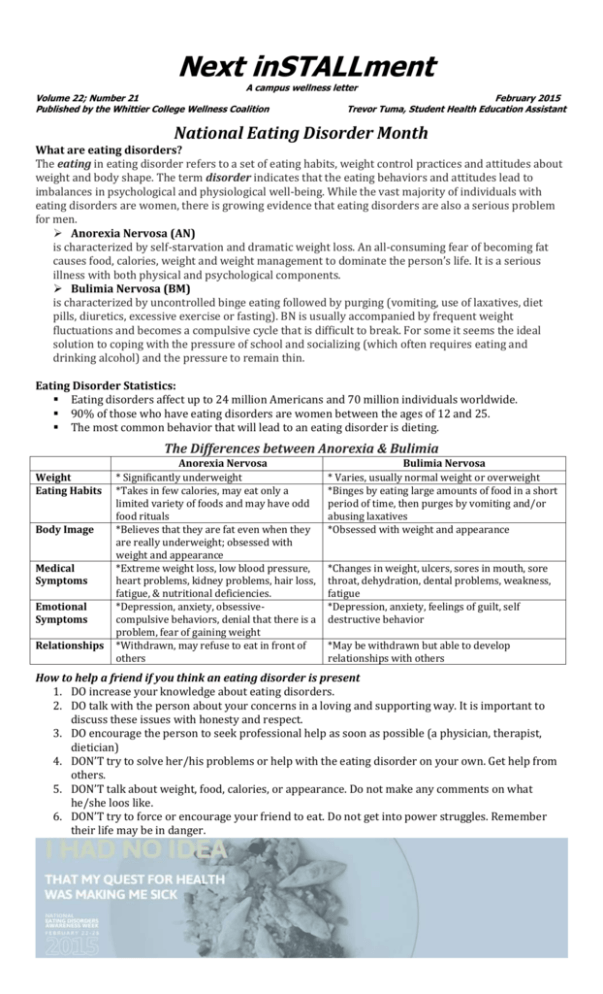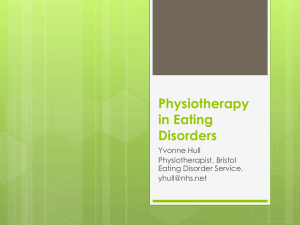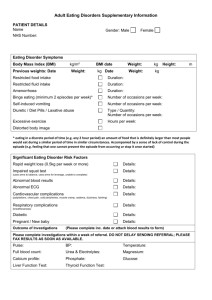Eating Disorders (Feb 2015)
advertisement

Next inSTALLment A campus wellness letter Volume 22; Number 21 February 2015 Published by the Whittier College Wellness Coalition Trevor Tuma, Student Health Education Assistant National Eating Disorder Month What are eating disorders? The eating in eating disorder refers to a set of eating habits, weight control practices and attitudes about weight and body shape. The term disorder indicates that the eating behaviors and attitudes lead to imbalances in psychological and physiological well-being. While the vast majority of individuals with eating disorders are women, there is growing evidence that eating disorders are also a serious problem for men. Anorexia Nervosa (AN) is characterized by self-starvation and dramatic weight loss. An all-consuming fear of becoming fat causes food, calories, weight and weight management to dominate the person’s life. It is a serious illness with both physical and psychological components. Bulimia Nervosa (BM) is characterized by uncontrolled binge eating followed by purging (vomiting, use of laxatives, diet pills, diuretics, excessive exercise or fasting). BN is usually accompanied by frequent weight fluctuations and becomes a compulsive cycle that is difficult to break. For some it seems the ideal solution to coping with the pressure of school and socializing (which often requires eating and drinking alcohol) and the pressure to remain thin. Eating Disorder Statistics: Eating disorders affect up to 24 million Americans and 70 million individuals worldwide. 90% of those who have eating disorders are women between the ages of 12 and 25. The most common behavior that will lead to an eating disorder is dieting. The Differences between Anorexia & Bulimia Weight Eating Habits Body Image Medical Symptoms Emotional Symptoms Relationships Anorexia Nervosa * Significantly underweight *Takes in few calories, may eat only a limited variety of foods and may have odd food rituals *Believes that they are fat even when they are really underweight; obsessed with weight and appearance *Extreme weight loss, low blood pressure, heart problems, kidney problems, hair loss, fatigue, & nutritional deficiencies. *Depression, anxiety, obsessivecompulsive behaviors, denial that there is a problem, fear of gaining weight *Withdrawn, may refuse to eat in front of others Bulimia Nervosa * Varies, usually normal weight or overweight *Binges by eating large amounts of food in a short period of time, then purges by vomiting and/or abusing laxatives *Obsessed with weight and appearance *Changes in weight, ulcers, sores in mouth, sore throat, dehydration, dental problems, weakness, fatigue *Depression, anxiety, feelings of guilt, self destructive behavior *May be withdrawn but able to develop relationships with others How to help a friend if you think an eating disorder is present 1. DO increase your knowledge about eating disorders. 2. DO talk with the person about your concerns in a loving and supporting way. It is important to discuss these issues with honesty and respect. 3. DO encourage the person to seek professional help as soon as possible (a physician, therapist, dietician) 4. DON’T try to solve her/his problems or help with the eating disorder on your own. Get help from others. 5. DON’T talk about weight, food, calories, or appearance. Do not make any comments on what he/she loos like. 6. DON’T try to force or encourage your friend to eat. Do not get into power struggles. Remember their life may be in danger.









